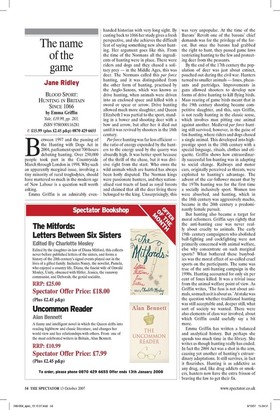The name of the game
Jane Ridley BLOOD SPORT: HUNTING IN BRITAIN SINCE 1066 by Emma Griffin Yale, £19.99, pp. 283, ISBN 9780300116281 £15.99 (plus £2.45 p&p) 0870 429 6655 Between 1997 and the passing of the Hunting with Dogs Act in 2004, parliament spent 700 hours debating hunting. Over 250,000 people took part in the Countryside March through London in 1998. Why such an apparently marginal issue, involving a tiny minority of rural troglodytes, should have mattered so much in the modern age of New Labour is a question well worth asking.
Emma Griffin is an admirably evenhanded historian with very long sight. By casting back to 1066 her study gives a fresh perspective, and she achieves the difficult feat of saying something new about hunting. Her argument goes like this. From the time of the Normans all the ingredients of hunting were in place. There were riders and dogs and they chased a solitary prey — in the Middle Ages, this was deer. The Normans called this par force hunting, and it was distinguished from the other form of hunting, practised by the Anglo-Saxons, which was known as drive hunting, when animals were driven into an enclosed space and killed with a sword or spear or arrow. Drive hunting allowed much more slaughter, and Queen Elizabeth I was partial to the sport, standing in a bower and shooting deer with a bow and arrow, but after her it died out until it was revived by shooters in the 18th century.
Par force hunting was far less efficient — the ratio of energy expended by the hunters to the energy used by the quarry was absurdly high. It was better sport because of the thrill of the chase, but it was divisive right from the start. Who owns the wild animals which are hunted has always been hotly disputed. The Norman kings were passionate hunters, and they nationalised vast tracts of land as royal forests and claimed that all the deer living there belonged to the king. Unsurprisingly, this was very unpopular. At the time of the Barons' Revolt one of the barons' chief demands was for the privilege of the forest. But once the barons had grabbed the right to hunt, they passed game laws restricting hunting to the few and protecting deer from the peasants.
By the end of the 17th century the population of deer was just about extinct, poached out during the civil war. Hunters turned to smaller animals — foxes, pheasants and partridges. Improvements in guns allowed shooters to develop new forms of drive hunting to kill flying birds. Mass rearing of game birds meant that in the 19th century shooting became competitive slaughter, and this, says Griffin, is not really hunting in the classic sense, which involves man pitting one animal against another. Medieval par force hunting still survived, however, in the guise of fox-hunting, where riders and dogs chased a single animal. This developed into highprestige sport in the 18th century with a special language, rituals, clothes and etiquette. Griffin shows how extraordinarily successful fox-hunting was in adapting to social change. Railways and motor cars, originally perceived as threats, were exploited to hunting's advantage. The advent of the car-follower meant that by the 1970s hunting was for the first time a socially inclusively sport. Women too were absorbed, and hunting, which in the 18th century was aggressively macho, became in the 20th century a predominantly female pursuit.
But hunting also became a target for moral reformers. Griffin says rightly that the anti-hunting case was never really about cruelty to animals. The early 19thcentury campaigners who abolished bull-fighting and cockfighting were not primarily concerned with animal welfare, else why concentrate on such marginal sports? What bothered these busybodies was the moral effect of so-called cruel sports on the participants. The same was true of the anti-hunting campaign in the 1990s. Hunting accounted for only six per cent of foxes killed. It was a trivial issue from the animal welfare point of view. As Griffin writes, 'The fuss is not about animals, so much as it is about us.' At stake was the question whether traditional hunting was still acceptable and, deeper still, what sort of society we wanted. There were also elements of class war involved, about which Griffin could usefully say a bit more.
Emma Griffin has written a balanced and analytical history. But perhaps she spends too much time in the library. She writes as though hunting really has ended. In fact the 2004 Act was a shot in the arm, causing yet another of hunting's extraordinary adaptations. It still survives, in fact it flourishes. Hunting is as addictive as any drug, and, like drug addicts or smokers, hunters now have the extra frisson of braving the law to get their fix.



































































 Previous page
Previous page